#on the same level as the Silverstone winners trophy
Text
That Hungarian trophy is sexy
5 notes
·
View notes
Text
Ok but a fic where Oscar goes to Ferrari in 2028. He takes Lewis’ seat after Lewis retires. Oscar announces his move during the pre-race conference and wins the championship. People don’t even believe it until McLaren and Ferrari posts an official announcement. It’s a shocking move. No one could have seen it coming.
Because why would Oscar leave a team that’s fighting for championships for a team that’s fighting for points? He would have to be out of his mind for that or Lewis has to be pure magic to be such a good convincer. Oscar finds out it’s a mix of both (Lewis a bit more. He can’t let anyone know that.)
2028 and it’s a whole turnout. Ferrari is on podiums much more. Oscar is in the championship fight with Lando, Alex, Charles, Max, George.
It gets…weird. Because he has George’s attention now. They have always been friendly as drivers, played padel together, talked during drivers parade, shared podiums together. But George’s attention on him is different now.
He is touchier and forces himself into Oscar’s space more. He’ll find George staring at him at times and smile when caught.
It’s after Australia, Oscar still feeling high from winning his home race, that he gets an idea onto why that is. He is casually scrolling through Instagram when he comes across a post. It’s a side by side comparison of him and Lewis winning for the first time with Ferrari. They did the same thing, the same exact thing. Step on top of the car, point at the prancing horse and run to their team. Turn around, only to stumble into George who stood behind them and get enveloped into his arms before they could say anything. The placement is the same: arms around their waist and head perched in the crook of their necks.
It’s nothing new. Being compared to Lewis. People have said they see a lot of Lewis in him over the years. George might be one of those people too, Oscar thinks. He sees Lewis instead of him. It would make sense why George has been so close to him. It couldn’t have been easier to have his idol retire. A grid without Lewis Hamilton.
—
Silverstone GP comes. And Oscar has never cared about this place much. Of course he wants to win every race but if there is a list of GPs Oscar cares from most to least, Silverstone would be right at the bottom. It would be at the last. But he enters the garage and Lewis is there, attending the first GP since he retired. The hunger is insatiable. Oscar wants to win a GP in a way he has never before. He wants to win it for himself. He wants to win for the man that holds the record in this place, wants to win at a place where the man is loved the most.
Oscar’s front wing is at level with George’s rear tyres. George crosses the finish line first. He breaks the Silverstone curse. For the first time in Formula 1, George wins his home race.
It’s on the podium that Oscar sees George in his true light, basking under his home crowd as if he is the prince. Lewis is in front of the winner with the trophy, inked invisibly of the same name as the one carved into the heart of the seven world time champion.
Oscar drops the facade, watches intensely as Lewis gives the trophy to George, the two of them don’t look away from each other once. It could have been him. Oscar could have been P1 if Lando didn’t make contact with him on lap 1, if his team had pulled a faster pit stop, if he didn’t make that rookie mistake. Lewis could have handed him the trophy, inked invisibly of the same name as the one written into the heart of the seven world time champion.
That was George’s motivation, too. Or at least one of it.
Lewis.
It always came down to Lewis, didn’t it.
Lewis pulls his hands from underneath George’s and walks away.
Champagne is popped and sprayed. Oscar steps on the top step of the podium, ignoring the sick feeling at the bottom of his stomach, and wraps on arm around George’s waist.
Oscar wants to lick the champagne off George’s skin, see if the winner’s champagne tastes different.
He knows Lewis shares his desires. The mystery lies in who would George choose for tonight.
Oscar twists his head. George is smirking at Oscar.
Lewis is George’s predecessor as much as he is Oscar’s. The realisation sets in. George and Oscar are both Lewis’ successors. Mercedes. Ferrari. Both covered in blood. The only difference is the colour.
That’s when the championship fight turns personal for Oscar. It’s not the first time they have been in fight against each other but it has never felt this personal behaviour. It’s up there with his battles with Lando.
It’s just a whole vibes of whether George is falling in love with Oscar or he is falling in love with the ghost of Lewis? And a bigger question is if he fell in love with Lewis or did he fell in love with Lewis Hamilton, the racing driver? If George will continue to love Lewis despite the fact that Lewis is retired now and not a driver? If George’s love circles back to racing.
#seems out of reach with oscar moving to ferrari and stuff but who cares#it’s a fic for a reason#something about george being haunted by lewis through oscar#had to get these thoughts out of my mind#gewiscar#ideas box
6 notes
·
View notes
Text
ARTICLE: "Driver Profile: Charles Leclerc" (Formula Scout, 2015)
PaddockScout profiles Charles Leclerc, the young man from Monaco tearing up the FIA F3 European Championship with two wins from the first two rounds.

Monaco plays host to probably the most famous of any Formula 1 race each year but, perhaps unsurprisingly for a microstate of less than 40,000 people, it doesn’t have a history of producing its own successful Formula 1 drivers. Louis Chiron won his home race in 1931 but since his last participation in 1958 (the oldest ever F1 driver at 58), only Olivier Beretta in 1994 has represented Monaco in an F1 race. Clivio Piccione and Stefano Coletti have won in GP2 since then, but didn’t make it to the top level.
Charles Leclerc is only 17 but he is probably Monaco’s best chance yet of repeating Chiron’s home streets victory. A long-time protege of F1 driver manager Nicolas Todt, Leclerc was a star in karting and has had no trouble adapting to single-seaters, impressing in Formula Renault 2.0 last year and now taking up the mantle of being the star rookie in European F3. A winner on his debut at Silverstone, he added a second victory at Hockenheim last weekend and is just five points off the standings lead.
A quick history (so far)
Leclerc’s father Herve was a Formula 3 driver in the 1980s, and Charles began karting at the circuit owned by Philippe Bianchi, the father of Jules. Working his way up the ranks, Leclerc was French was French cadet champion in 2009 and the runner-up in KF3 and the Monaco Junior Kart Cup winner in 2010.
The following year, he claimed a CIK-FIA double, winning the Academy Trophy and the KF3 World Cup. Moving up to KF2 for 2012, Leclerc triumphed in the WSK Euro Series and took second in the European and U18 championships.

Together with Max Verstappen, Leclerc took part in the KZ gearbox classes for his final year in karting in 2013, winning the Winter Cup and finishing second to his Dutch rival in the world championship.
Leclerc entered Formula Renault 2.0 for his rookie single-season season, embarking on the Alps series for Fortec Motorsports. He quickly became a frontrunner, making the podium at round two at Pau and then twice again at Spa. At Monza he won both races, and followed that with more podiums to secure second place in the championship behind third-year FR2.0 racer Nyck de Vries.
Some of Leclerc’s most impressive performances last year came in Eurocup Formula Renault 2.0 as a guest entry. He took part in six races and finished second in the last three of those, up against lots of drivers with multiple years of experience in the series.
He could have made the full-time move to the Eurocup for 2015 but instead stepped up to Formula 3, and after testing for several different teams, signed with Van Amersfoort Racing. He would essentially replace Verstappen as team leader, working with the same engineer Rik Vernooij.
Leclerc was rapid in testing and demonstrated his pace on his debut weekend at Silverstone, scoring a double position and winning the final race of the weekend. At round two at Hockenheim he extended his podium streak to five consecutive races, and defeated F3 veteran Felix Rosenqvist in a battle for victory in the wet in race three.
Up next
Leclerc is just five points behind championship leader Antonio Giovinazzi, and so far he’s only raced on circuits he hadn’t competed at before. Next up on the calendar are Pau, Monza and Spa, and he tasted success at all of those last season. Therefore, it stands to reason that there’s yet more to come from Leclerc.
It’s a long season (there are 33 races) and plenty could happen between now and the F3 paddock returning to Hockenheim on the weekend of Leclerc’s 18 birthday in October. But based upon the first two rounds, there’s no reason to think of Leclerc as anything other than a serious title threat. Beating the more experienced Rosenqvist and Giovinazzi – driving for bigger teams in Prema and Carlin respectively – will take some doing, but he’s already given them a hard time. Anyway, his season’s hardly going to be a failure if he loses out and finishes up third as a rookie.
Talent and potential

Leclerc marked himself out as a real prospect in karting – so much so he topped our 2012 ‘karters to watch‘ feature, ahead of Verstappen. But it’s never a foregone conclusion that a successful karter will make a successful car racer. His debut season in FR2.0 was in some ways fairly low key with ‘only’ two wins, but the jump up from karting to continental FR2.0 is very rarely made to look easy by anybody. Leclerc ultimately finished as high up in the Alps standings as he could have been realistically expected to do so, given the presence of an on-form de Vries. It was actually up against tougher competition in the Eurocup that he really shone, with three consecutive P2s taking quite some doing in a series where nobody was particularly consistent.
Those performances suggested he would be capable of stepping up to F3, particularly as his old rival Verstappen had made it look easy and didn’t have the benefit of a year of car racing experience. And so he has proven to be. It’s still early days, but Leclerc has so far been the class of a large crop of rookies and taken the fight to proven F3 winners with multiple years of experience already under their belt.
His early performances are on a par with what last year’s star rookies Esteban Ocon and Verstappen were doing – in fact, his record of two wins and five podiums from the first six races replicates the 2014 champion’s start. If he keeps it up, he will deserve to be held in the same high esteem as them a few months down the line.
Off-track
No doubt assisted by the Bianchis’ tutelage, Leclerc signed with Todt Jr’s All Road Management firm in 2011. At present, Leclerc has no ties to F1 teams, but through his work with Felipe Massa, Pastor Maldonado and Bianchi, Todt has dealt with most of them and will be very well-placed to get his protege a role when the time comes.
A potential stumbling point is that most F1 teams are already overflowing with some serious sub-F1 prospects, but if he continues to impress as he’s doing at the moment, they could begin falling over each other to find a space for him.
Funding-wise, Leclerc benefits from partners usually tied to Todt’s projects, and watch maker Richard Mille (currently a sponsor of the Lotus F1 team) is his loyal main backer. And you’d imagine that being billed as a future F1 star from Monaco could well tempt some further future investment.
Verdict
In just his second season in single-seaters, Leclerc is quickly marking himself out as a star of the future with fine performances and two wins in his first couple of weekends in European F3, making him seriously stand out from a large and competitive grid.
While he’s got plenty in common with his old karting rival and Van Amersfoort F3 predecessor Verstappen, a lesser reputation and sensible management mean he’s unlikely to be making the jump straight up to F1 next year. He will therefore need to sustain this impressive form into an intermediate category like GP2 in order to make the grade.
But the signs are definitely there that Leclerc is one of the very top talents in the junior ranks right now, and that he’s capable of tasting success in F1 in the future.
His lifelong friend Bianchi was so sadly stopped in his tracks last year just when his F1 future was looking promising. In a few years’ time, Leclerc could just pick up where his mentor left off.

16 notes
·
View notes
Text
penman47 asked: Your pages on Stirling Moss and Graham Hill have brought back fond memories of my passion for Formula 1 racing and the Grand Prix races from 1963 through1972. Mechanical failures often plagued Stirling Moss, Graham Hill and Jimmy Clark as man put machine to test. My question would be who of the three would come out on top driving the same mechanically perfect car at say the British Grand Prix Silverstone.
Thank you for your question @penman47
I received this question just before the sad news about the recent untimely death of the legendary Sir Stirling Moss. It feels prescient to respond now after a bit time to pass to reflect with a more sober perspective rather than let sentiment and emotion cloud any judgement.
In my family we are, it is fair to say, racing nuts. My grandfather had the racing bug and drove classic cars at amateur meets like Goodwood through his friendship with Freddie Richmond and was involved heavily in the RAC Club. He was fortunate to see all three of these racings icons race. He saw all of Jim Clark’s five victories at the British Grand Prix and regularly went to Monaco to see Graham Hill win there five times. He saw Stirling Moss race too and he was there for the Glover Trophy at Goodwood in 1962 when Stirling Moss had his career ending accident. Without taking anything away from the modern era drivers like Alain Prost, Ayrton Senna, Michael Schumacher, and Lewis Hamilton - all of whom he thinks are a credit to motor racing - he is very much of his era. As a proud Scots, he thinks Jim Clark was the best he ever saw.

My father got the racing bug too but was more of a Le Mans fan when he was growing up because spectators were closer to the action than F1. He had inherited and also built up his own classic car collection that he sometimes races at Goodwood. He was a wee laddie when he saw Clark and Hill race but he doesn’t fully recall because he was too young to fully remember. He loved watching James Hunt, Ayrton Senna and Alain Prost but had a grudging respect for Nikki Lauda. He never saw Stirling Moss race but knew him quite well through Goodwood and at the RAC Club in London. I know his head says Jim Clark but his heart says Stirling Moss was the best British driver.

For one of my older brothers, who has a thing for speed as I do, he was always a big Ayrton Senna fan. Again as a small boy he saw Ayrton Senna race and was part of the converted to consider him as the greatest driver of all time. Senna’s bravery was his own inspiration to take part in the Dakar Rally and other endurance races.
It’s indeed one of my unmet ambitions to ride in the Dakar Rally but it’s always been on the back burner. I would like to ride with my brother because he has the experience but he and I are too competitive and we would fight over who was the better driver - for the record, I know I am.
My mother - being Norwegian - is left to make dry sarcastic remarks about boys and toys whenever my grandfather, father and us siblings talked about racing. But she’s not immune to the glamour of F1 racing either. I’ve been told by my aunts that when my mother was at her Swiss boarding school, and later learning to be a ski instructor in the Alps, she would descend upon Monaco during the Grand Prix with her friends and enjoy the social side of racing i.e. the partying side of Formula One racing. But she’s quite buttoned up about her partying past. Meanwhile she and my other siblings continue roll their eyes when the subject of racing comes up.

But speaking for myself, speed has been my drug of choice and flying combat helicopters in the army for a time helped satiate that need. When I left I felt empty and bereft. But if flying single craft planes and gliders gives me weird sense of peace these days (when I can make the time to do so), I get a decent rush from riding motorbikes hard and fast on the open country roads (forget about the urban traffic congested cityscape). Racing the odd fast car I managed to get my hands on through pliant boyfriend or good friend has given me a brief thrill too but it’s been spoiled often with my driving companion screaming in my ear or pissing their pants as I take the turn hard. With my penchant for crashing - tsk, more like a graze - I’m not allowed any where near my father’s classic cars.
I have been to Grand Prix races, including ones at Silverstone, Spa-Francochamps, Singapore, Shanghai, Suzuka, Yas Marina, Monza, and Monaco, from the time I was at boarding school. I would either go as a guest of my grandfather or father or even with some school friends who lived in Monaco and had links to get entry into the drivers’ paddock. But these days it’s more likely because of wrangling a corporate hospitality invitation that I would have the chance to go - sometimes if I plan my calendar fortuitously and Lady Luck smiles upon me I can catch two birds with one stone e.g. do a business trip to Shanghai and stay on to see the Shanghai Grand Prix. So I follow racing avidly if I can. For me of course the amazing Lewis Hamilton is the driver of our generation along with Michael Schumacher’s imperious reign at the top. And I do like the cut of Max Verstappen’s gib too.
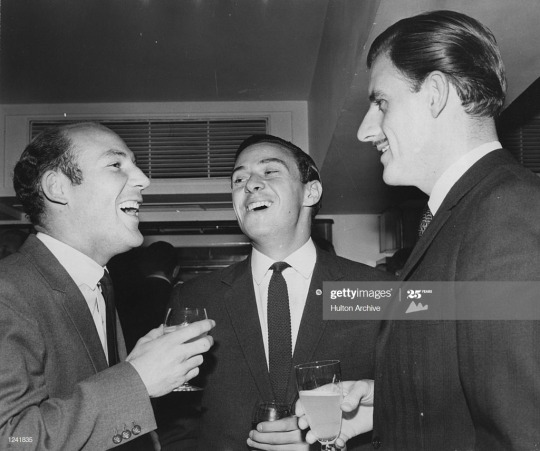
Of course it’s hard for me to credibly assess who was the better driver between Stirling Moss, Graham Hill, and Jim Clark because I wasn’t a direct witness but not many today were either. But I consider myself a racing fan and I have seen old footage. I have also read about the history of Grand Prix racing and listened to others whose expert views I respect. So I hope what I offer is just an educated opinion at the end of the day but I recognise the heart will come into it because racing - at least in the vintage years - was quite romantic even as it morphed into something more glamorous in later decades.
Anyway, your question just added more fuel to the fire in our family discussions over our recent Zoom calls.
I have to say upfront that I consider Jim Clark as the greatest British driver of all time. I’m with my grandfather on this one and I always enjoy playing contrarian to my father(!). But all things considered Jim Clark was on a different level to both Stirling Moss and Graham Hill. And why I think so I hope I can lay that case out below.

It’s important to put all three drivers in their racing context.
Firstly, they all didn’t race at their peak at the same time and in the case of Moss in a different era. But there was some overlap between Moss and Clark and Hill. Stirling Moss had active career from 1951-1961. Graham Hill had his active years between 1958 to 1975. And Jim Clark was only active for eight years from 196O to 1968.
Secondly, unless you’re a racing fan or have seen old film footage, it really is hard to convey to our present times just how dangerous driving was in that era. It was known as the Killer Years in Formula One history. Back in the days when the British government leached up to 97 per cent from a race driver’s income, a racer had at least a 40% chance of dying at the wheel, so tragedies were commonplace. Some prodded the tiger once too often and ran out of luck. It really is hard for us to fathom the extreme danger Grand Prix drivers put themselves under when they hared around the track as one mistake might well cost them their life or a body of broken bones.
And thirdly, it may sound simple to say this, but they drove extremely fast at very high speeds. The temptation again is to look at vintage racing cars in the light of modern super engineered racing cars and think they were easy to drive.

Few drivers in the history of motor sport can prove they’ve won the elusive Triple Crown. Only Graham Hill can. Formula One world champion in 1962 and 1968; winner of the 1966 Indianapolis 500; winner of the 1972 24 hours of Le Mans and five time Monaco GP winner. An incredible achievement that underlines the fact that Hill was one of the most complete drivers of his time. He was fast, but not the fastest. Talented, but not the most talented. The best, but not always and everywhere. Explosive, but predictable. Professional, but with enough self-mockery to pull his pants down at dinner parties, running up and down the tables. Hill drove his cars throughout the most dangerous years of the sport. Calmly and reserved, while he tried to fight off virtuoso's like Jim Clark, Jochen Rindt and Jackie Stewart.

When Stirling Moss drove on the track, he was there to race, not to eke out championship points. And to do it fast, faster than anyone else. For a driver whose competitive peak coincided with one of motor racing’s most dangerous periods when death regularly stalked all drivers, a time when average lap speeds escalated while safety precautions stood still, Moss’ courage and achievements were even more astonishing. Moss knew all about that: witness the serious leg injuries he suffered during practice for the 1960 Belgian Grand Prix, a race in which compatriots Chris Bristow and Alan Stacey both died, or the career-ending aftermath of his accident during the 1962 Glover Trophy at Goodwood.
But for his own unswerving sense of fair play, he could have pipped Mike Hawthorn to become Britain’s first world champion in 1958. Moss won four races to his rival’s one, but the latter benefited from greater reliability and consistency. The pivotal moment came in the Portuguese Grand Prix, from which Hawthorn was initially stripped of second place for receiving a push-start after slithering off the track. Moss was among those who came to his defence.

To this day Moss has won more world championship grands prix than any other driver never to have secured the championship, despite the ever-escalating number of such races. He has always maintained that he’d like to remembered as “a driver who preferred to lose while driving quickly than to win by driving slowly enough to get beaten”. For a few years, after the retirement of the great Juan Manuel Fangio in 1958, he was the finest and most famous racing driver in the world. He was so good that Ferrari not only wanted him to drive for them but were prepared to have the car painted blue, the team colour of his friend Rob Walker. And it is worth remembering that Enzo Ferrari rated Moss ahead of Fangio and placed him alongside Tazio Nuvolari. He is, perhaps then, the ultimate proof that raw racing statistics sometimes mean very little when you are natural racer.

Jim Clark’s raw racing statistics spoke volumes for his achievement and the astonishing records he set, a few of which still remain unsurpassed. More than that he has been hailed as one of the top three drivers of all time in any reputable survey. His achievements were a reflection of the awe and admiration many of his driving peers and others since his untimely tragic death have held about the man and the racer.
Clark began matching Stirling Moss’s speed in the second half of the 1961 season, and took over the Englishman’s mantle in 1962 when Moss was injured in a crash at Goodwood on Easter Monday. Clark narrowly lost the World Championship that year to BRM rival Graham Hill, after his Lotus developed an oil leak while dominating the finale in South Africa. Two years later he lost another championship to an oil leak, literally on the last lap of the season-closing Mexican GP. The honours fell instead to John Surtees. But in 1963 and 1965 Clark was unstoppable in Colin Chapman’s green and yellow Lotuses, and their driver/engineer relationship was symbiotic.
Jim Clark not only won his second title in 1965 but he did so by leading every single lap of every race he finished in the 1965 season. Therefore, he won every race he finished with what we now call lights to flag victories. It was an incredible feat which has been unmatched by the other truly greats of the sport, Fangio, Senna, or Schumacher.
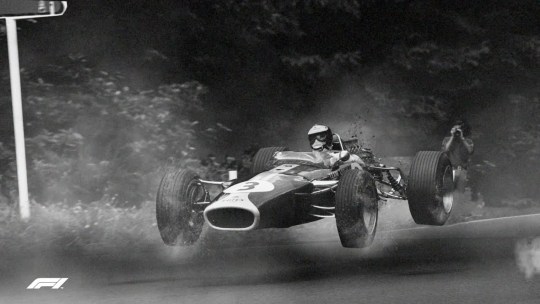
In 1963 only some obfuscation by the establishment at Indianapolis Motor Speedway in favour of the traditional front-engined roadsters prevented him from beating Parnelli Jones to victory on his Indy 500 debut in Chapman’s rear-engined Lotus ‘funny car’. He led the 1964 Indy 500 race before his rear suspension broke, and in 1965 dominated the event and became the first Briton to win this iconic race since Dario Resta in 1916.
Clark remains the only man in history to have won the Formula One World Championship and the famed Indianapolis 500 in the same year (1965).
His tally of 25 victories was a record at the time. It has since been surpassed by several other drivers, but none in so few races. Clark's came in just 72 starts, a win ratio surpassed only by Alberto Ascari and Juan Manuel Fangio.
Likewise, his tally of 33 total pole positions was first passed by Sebsatian Vettel, with only Ayrton Senna, Michael Schumacher and Lewis Hamilton ahead of Clark. But in percentage terms, Clark is ahead of them all. He was on pole for 45.2% of his races - only Fangio, on 55.8%, did better.
Those numbers give a sense of how Clark towered over his era, a period when he made many grands prix mind-numbingly boring, so completely did he and his Lotus dominate them. Yes, the Lotus was often the best car, but Clark's supremacy was not in doubt. His two titles in 1963 and 1965 were exercises in crushing superiority, and he would have won in 1964 and 1967 as well had it not been for the notoriously poor reliability of Lotus's cars.
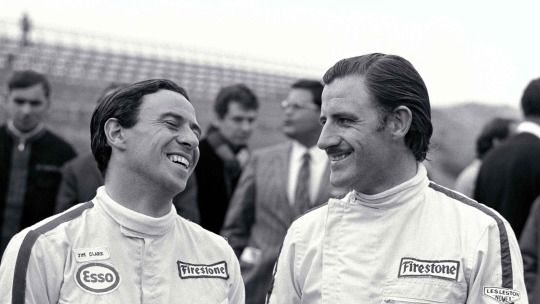
But does any of this tell us which of the three would have won between the three of them at the British Grand Prix as you suggest?
Graham Hill may have been the monarch of Monaco - his nickname was after all ‘Mr Monaco’ with his magisterial six wins between 1963 and 1969, a record only bettered by the great Ayrton Senna - but much to his regret he never won a British Grand Prix race.
Stirling Moss won two British Grand Prix races in 1955 driving a Mercedes car and in 1957 where he shared a drive in a Vanwall car with Tony Brooks.
Jim Clark won the British Grand Prix an astonishing five times. In 1962, 1963, 1964, 1965 he won driving the same Lotus-Climax car and in 1967 he won with a Lotus-Ford car. His five victories were a record that stood through the subsequent decades until Alain Prost equalled Clark’s tally in 1993 (Prost won on and off between 1983 and 1993). Clark’s record was only surpassed in 2019 when Lewis Hamilton won his amazing sixth victory at the British Grand Prix (with perhaps more to come). Even more remarkable was how peerless Clark’s domination was as he won four British Grand Prix races consecutively. It was yet another amazing record that belonged to Jim Clark until Lewis Hamilton joined him in the record books with four straight wins (2014-2017).
It might be churlish to point out that Stirling Moss, like Graham Hill, never won at Silverstone even when he raced there. Clark won three times.
In those days the British Grand Prix was not always held at Silverstone. Between 1926 and 1986 the venue track chosen rotated between Brooklands and Silverstone, then Aintree and Silverstone, and later Brands Hatch and Silverstone. Only from 1987 onwards to the present day did Silverstone become the established venue race track of the British Grand Prix.
Moss’ two British Grand Prix victories were both achieved at Aintree (1955 and 1957). The British Grand Prix races that Moss did compete at Silverstone he retired due to engine or axle trouble.
In contrast Clark won his first British Grand Prix victory at Aintree in 1962, and another one at Brands Hatch in 1964 but the other three victories were at Silverstone.
So one would have to give the win to Jim Clark on paper.
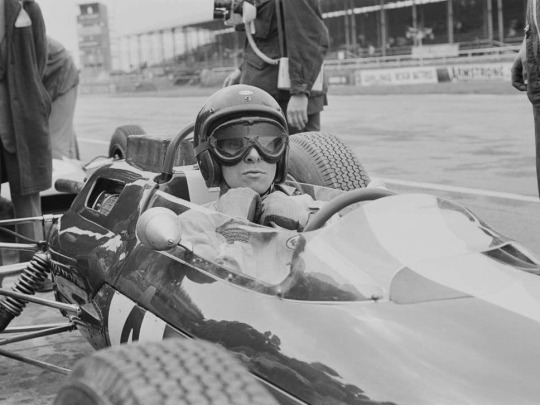
But some may argue yes, that’s all well and good but who was the fastest driver and who really was the better driver?
Here again the stats speak for themselves. The all time list of fastest laps set during their respective careers gives us some clue because the tracks they drove on were the same during their eras. Graham Hill is 34th on the all time fastest laps set with 10 fastest laps in the Grand Prix races he drove in a 17 year career (1958-1975). Stirling Moss is 15th on the all time fastest - one position above Ayrton Senna - where he set the fastest laps in 19 Grand Prix races in his 10 year career (1951-1961). Jim Clark is 7th on the all time fastest laps set by a Grand Prix driver. He recorded 28 fastest laps in Grand Prix races in his 8 year short racing career (1960-1968). Only Mansell, Vettel, Prost, Raikkonen, Hamilton and Schumacher as 1st stand ahead of him. What makes Clark’s achievement staggering is that he was competing in an era where technology was in the Bronze Age compared to the modern marvels of technology, aerodynamics, and speed. It’s also worth noting all the other drivers had much longer racing careers than Clark did before his untimely death. At the 1968 South African Grand Prix - his last before his death in Hockenheim ring in Germany 3 months later - Clark won way ahead of the pack led by Graham Hill who came in second. He was comfortably on his way to another world championship with more records to be smashed.
Clark still holds the record of eight Grand Slam race wins - that is winning pole position, putting in the fastest lap, and leading every lap of a race to the win. Only Lewis Hamilton comes close with six and Schumacher and Ascari with five. He achieved this twice at the British Grand Prix in 1962 (Aintree) and 1964 (Brands Hatch). Again it needs to be emphasised that Clark did all this while driving in the most dangerous era of Formula One - The Killer Years - where death of drivers and lack of driver and track safety was all too common. This is simply astonishing.
Of the three, Jim Clark was the fastest. I think this isn’t just about stats it’s also the they way they drove that made all three such great racers. All three certainly had limitless courage that even now demands total respect and awe. In particular it’s breath taking watching old film footage of Moss driving his most famous and greatest victory of all was the 1955 Mille Miglia in which he covered 1,000 miles of open Italian roads at an average speed of 97.96mph in 10 hours, seven minutes and 48 seconds.
But the fastest doesn’t make you best of course. When it comes to judging who was the best I think what their peers and contemporaries thought of them counts a lot in coming to some conclusions as to who was the best driver.
Sir Jackie Stewart, three times world champion and a team mate of Jim Clark as well as friends with all three drivers, is worth listening to.
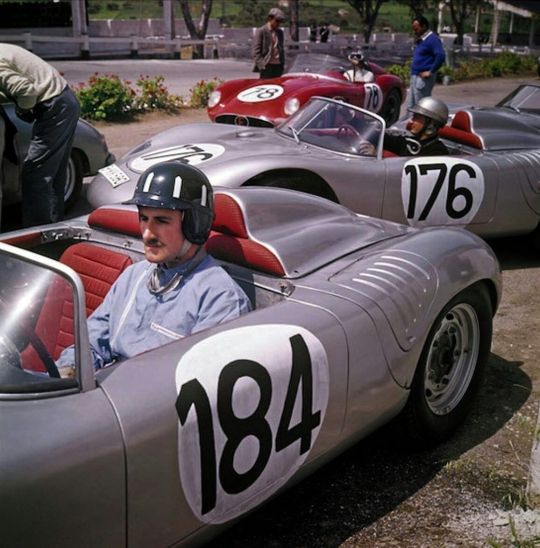
Many think that Graham Hill wasn’t the most natural driver. This isn’t said to slight him or doubt his abilities but to acknowledge his approach to driving. As Jackie Stewart said, “Whereas Jimmy [Clark], Stirling, to a certain extent myself, would drive around a car’s handling problem, Graham would fiddle with the car until it was right. Graham would take very different lines around a corner to others, and I know because sometimes I was following him.”
Sir Stirling Moss has echoed Stewart’s comments. “I’d go along with Jackie and say that Graham didn’t have a natural ability to drive a car extremely quickly. But having said that, when I was to choose a partner for a sports car race at say, the Nürburgring, I would always choose Graham because he was so reliable. Quick, but unlikely to do anything stupid.”
Jackie Stewart’s comment unearth one of secrets of why not only was Jim Clark the fastest but also the best of the three. Simply put Clark knew how to take corners and know when to brake.
It must be stressed that both Moss and Clark knew how to take corners and mastered the art of breaking to a level very few drivers reached whatever car they were driving.
Moss was certainly a pioneer in taking corners and knowing when and when not to brake. Moss - especially at his peak in the Lotus - would cut into the corner early and with the brakes on.
Most drivers run deep into a corner before turning the wheel. In this way a driver could complete his braking in a straight line, as is the standard practice and one everyone did and still do, before setting the car up for the corner. But natural drivers like Moss (and Clark) preferred to cut into the corner early and even with their brakes still on to set up the car earlier. In this way such drivers almost make a false apex because they get the power on early and try to drift the car through the true apex and continue with this sliding until they are set up for the next bit of straight. In other words, the result is a smooth line as you come out of the turn and race on at faster and more seamless speed.
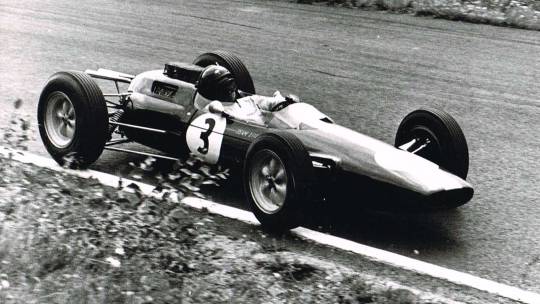
Clark would take this to the next evolutionary step from Moss - also in a Lotus - as cars became more mechanically challenging to handle. Clark placed a big premium on braking. In his book At the Wheel (1964) he expounded on this belief, "The most important thing you can learn in racing: how to brake. Often, if I want to go through a given corner quicker I don’t necessarily put the brakes on any later than usual, but I might not put them on very hard, and take them off earlier. Where you are led into the trap is leaving your braking too late and having to run deep into the corner and brake at the last moment, you might certainly arrive at the corner quicker, but there is a psychological tendency to brake much harder than you need to and therefore over-brake."
A good example of this is looking at footage of the 1965 French Grand Prix in Clermont-Ferrand where Jim Clark won from pole position and set the fastest lap around this new track that no one had driven on before (see below)
youtube
Fast forward to the 9 minute mark you will see all the top drivers of that era tackling a fast downhill left - unfortunately you don’t see Graham Hill, who had an off day and ended up 13th I think - but the point remains valid.
Jim Clark drives a Lotus in this 1965 French Grand Prix race and is bombing away from the rest of the pack as was his usual MO. The interesting thing to notice is the turn. Clark’s Lotus is 2-3 feet inside the painted white line as he turns into the corner. It’s really more of a smooth elegant sweep into the corner. Clark clearly turns in much more earlier with the brakes - as we now know - are lightly caressed. Clark smoothly glides through out of the turn as he disappears from view carrying crucial extra speed. Then the rest come and the difference is soon clear. Jackie Stewart’s BRM P261 car grazes the line and grappling with more understeer than he might have liked finds himself to the right of the dotted line when he comes out of the turn. The V8 Ferrari of the great John Surtees also grazes the line with a similar result. Dan Gurney’s Brabham BT11 car crosses the painted line and he pays for his aggressive stance by sitting cross the road’s dotted centre line. On this track at Clermont-Ferrand there were forty-eight corners in its five sinuous miles to perilously navigate and Clark using this MO had the nonchalant confidence and consistency as well as the driving artistry to increasingly pull ahead of the chasing pack to victory.
Analysing the Clark technique, Peter Collins (a former team manager at Team Lotus and Williams, and an avid Clark fan), who knows more about what makes great drivers than most, made a key observation, “His driving was incredibly fluid even in dramatic moments. Watching the first laps of various races you got a very strong impression that he was mentally more ahead of the car than was the opposition. Watching him leading at the ’Ring in 1967, for instance, the impressive thing was that there were no dead moments in transition from braking to turn-in, to throttle on. He was able to drive an understeering car in a four-wheel drift and judge the exits to perfection.”
Graham Hill, who was a good friend of Jim Clark’s as well as being a fiercely competitive rival on the track, knew better than most and so I shall let him have the final say on this. Hill in his penned eulogy to Jim Clark noted his mastery of taking the corner, “For a driver, the excitement of racing is controlling the car within very fine limits. It's a great big balancing act, motor racing. It's having the car broken away and drifting and doing exactly as you want it to do and getting around the corner as quickly as you can, and knowing that you've done it, and hoping that it is better than anyone else has done. You are aiming at perfection and never actually getting it. Now and then you say, "That's it. That's how I want to do that corner. Now beat that, you bastards." This is the essence of racing, and at this, Jimmy, in his era, was unsurpassed.”
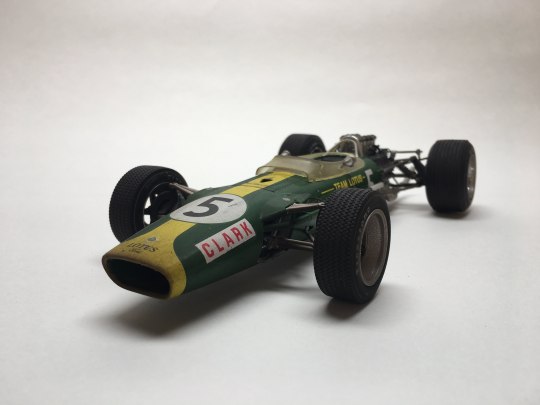
A word must be said about the cars these drivers drove. Racing cars in that era were extremely fast but also extremely unreliable. One can only lament how many world championships Moss, Hill, and Clark would have won if not for some mechanical car failure that did cost them dearly. In the case of Clark, he agonisingly lost the world championships in 1962 and 1964 due to oil leaks in the final race both times.
Of the three Hill was the most technical, not surprising given that he started life with the Royal Navy as a technician specialist. When he was racing Hill took notes of every test, every practice, every race and how his car handled specific track conditions and setups. He was constantly on top of his mechanics with these early versions of telemetry and his expertise on engineering meant that the difference between mechanic and driver was nothing more than a grey area. According to some of the mechanics who worked with Hill, it was sometimes impossible to please him. Both Moss and Clark by contrast didn’t really bother with that side but rather they just jumped into the car and worked around the problems on the track relying on their natural flair and genius. That’s how brilliant they both were.

So how would Moss and Clark fare if they both had the same car and barring any technical issues. There are no certainties but they did both briefly overlap in their careers, as Moss was coming to the end of his and Clark was about to start his ascension. The race that most would point to is the 1961 South African Grand Prix. Stirling Moss was the undisputed world's best in 1961, pulling off some famous victories in inferior equipment, but Clark's performances at the end of the season showed that things were changing. Clark's Lotus Climax 21 car had beaten the slightly older Lotus Climax 18/21 model of Moss in the Natal Grand Prix earlier in the month, but the East London race stepped things up a notch. Clark was fastest in qualifying and started on pole position with Moss +0.2 seconds behind.
Both Clark and his Team Lotus team mate Trevor Taylor led the way at the start but but Moss was soon into second and took the lead when Clark spun avoiding another car. Now Clark charged, despite sustaining gearbox damage, lapping faster than his pole time, and Moss was powerless to stop him coming through to win."Moss pulled in behind Clark and tried to stay in his slipstream but could not keep up with Clark's fast and furious driving and fell slowly, but surely, behind," read Autosport's report. "Clark demonstrated that the world championship is no pipe-dream for him." Clark was a little more circumspect, though beating Moss was clearly a watershed: "I had the satisfaction of beating Stirling twice in two weeks, although, in all fairness, my car was newer than his," he wrote in his 1964 book, Jim Clark - At the wheel.
That Clark was being characteristically modest and magnanimous isn’t the main point to take away. The point is made by Colin Chapman the iconic genius behind Lotus who said of Clark, “when there was no mechanical trouble, Clark absolutely blew away the opposition. One prime example of that was the 1967 German Grand Prix when the Lotus was not an easy car to drive but still Clark got pole in it by a staggering 9 seconds. This also brought out another of Clark’s skills – to drive around problems. He was capable of driving a car with any given setup – he never asked to change the setup to make it to his liking, he went out on track and tried to make the car go faster by adjusting accordingly at corners, which was very easy for him as he had a very smooth driving style and it never looked like he was trying to muscle the car across the corners.”
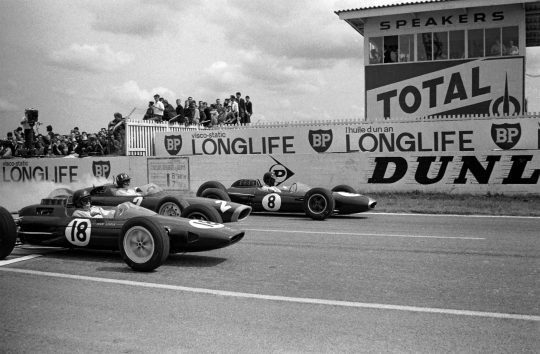
Once Clark was in front he was almost unbeatable. No matter who you were or how good you were, Clark was quicker and relentless. It was almost game over once Clark took the lead and slowly pulled away from the rest. Graham Hill said in his eulogy to Jim Clark, “He was also particularly competitive, particularly aggressive, but he combined this with an extremely good sense of what not to do. One can be overthrusting—aggressive to the point of being dangerous. Well, this Jimmy was not. But he was a fighter, a fighter that you could never shake off. He invariably shot into the lead and killed off the others, building up a lead that sapped their will to win.”
This is one main reason with all things being equal, Clark would beat Moss and Moss would beat Hill. The really scary thing about Clark’s complete mastery of driving was what Colin Chapman said years later, "I think Jim never drove really 100% - he was so good, he didn’t need it to beat the others. Perhaps only in Monza 1967 he had the knife between his teeth...."

Moss is rightly celebrated as an icon of motor racing. Moss had a fantastic 15 year career on the track and just as importantly he had an even longer one off the track as the fantastic ambassador of Grand Prix racing. Moss lived to be 90 years old and he used that time to deservedly cement his legendary status as a Formula One great. He was a very charismatic and convivial personality. He is revered by contemporary drivers and racing fans because his presence was anywhere and everywhere. No racing event would be complete without the vintage stardust of the great Sir Stirling Moss. At Goodwood and at the RAC Club racing enthusiasts would mill around him and listen to his endless yarns. At race circuits during the Grand Prix season his presence in paddock would stop everything as racers and technical crew were in awe of him.

In contrast Jim Clark’s racing career was tragically cut short to a mere 8 years and yet he had achieved so much at the age of 32 years old. Arguably his death had the greater impact because it was more keenly felt by his peers and those within the racing world. So when he was killed by a puncture during the wet Formula 2 Deutschland Trophy race at Hockenheim on 7 April 1968, after his Lotus crashed into unforgiving trees by the side of the track, race drivers around the world felt death’s hand on their shoulder, and asked themselves, “If it can happen to Jim Clark, what chance do we have?”
The consequence of Clark’s death cannot be stressed enough. Clark’s death was the sacrificial blood price for the more modern era drivers to race with greater driver safety measures in place and safer tracks for spectators that these days we today take for granted. A lot of credit is due to Clark’s close friend and team mate, the great Sir Jackie Stewart, who at the risk of his own personal reputation, pushed hard for the racing world to take driver safety seriously. A lot of danger - and perhaps even the excitement - has been taken out as Moss used to say. But there is no question racing - whilst still relatively dangerous because of the higher speeds they are pushing for those micro margin of victories - is much safer than the dangerous era of Moss, Hill, and Clark.
So why isn’t he more well known or revered by the general public (as opposed to hard core racing fans and those within the racing world)? I suspect it was due to his shyness and aversion to publicity. Clark grew up on a Scottish farm and he was clear to many that this was his roots that he always returned to. While he couldn’t entirely avoid the glamour of the racing world with its hedonistic side effects of women, sex and fast cars - as personified by Graham Hill or James Hunt - Clark eschewed all that in favour of simple living on his Scottish farm. His only indulgence was an airplane that he used to piloted into race circuits in Europe - Hill could fly too and it cost him his life in 1975 in a tragic plane accident. Clark simply loved racing. The proud Scot was a gentleman with self-deprecating charm and modesty to match. He was simply a good and decent man revered by his own peers in his own time.

At Clark’s funeral, Jim Clark Snr, beloved father, confessed to Dan Gurney, a racing rival, that he was the only man his son had feared. Gurney, who died in January 2018, spoke of Clark thus: “It is certainly an honour to have had the opportunity to know him as a team-mate, a friend, and to have competed with him on so many memorable occasions. Jim whipped us so many times that we all sort of got used to it. Naturally, we didn’t like being whipped, but, it is probably a testimony to Jim’s integrity and stature among us, his peers, that we couldn’t help loving the lad in spite of it.”
Elizabeth ‘Widdy’ Cameron, whom Clark nearly married in 1960, and with whom he stayed close despite rising fame, said: “He was very shy. And he was a terrific gentleman. I didn't hear him say bad things about anybody. He was a good, good man and I hope everybody remembers that. He was very special.” Sir Jackie Stewart, the three time world champion and another great British driver, still sheds a tear when he’s asked about Jim Clark. The two Scots were close friends, and three years earlier when Stewart had arrived in F1, he played the Robin role to Clark’s undisputed Batman. “Jim Clark,” he says still, “was everything I aspired to be, as a racing driver and as a man.” When Jim Clark this humble man as a product of his upbringing on a Scottish farm in the Scottish Borders insisted that inscribed on his tomb stone would be, ‘farmer and world champion’.
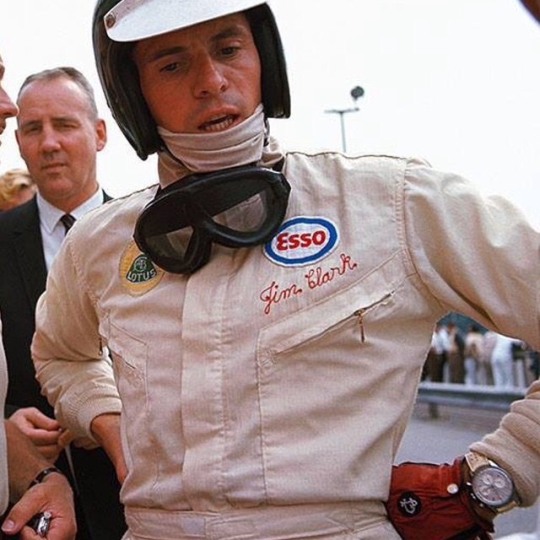
Of course I never saw Moss, Hill and Clark race but I’m definitely in the camp that considers Jim Clark as not only the greatest British driver of all time but also arguably the best driver in the world of all time alongside that other most naturally gifted racer, Ayrton Senna. There’s not much to differentiate their greatness and genius.
It’s fitting that the final judgement of who was the best driver of the three should rest with their peers and contemporaries. Juan Manuel Fangio, the Argentine great is one of my favourite racers and one who is also considered one of the greatest of all time, said this about Clark in 1995: "He was better than I was - the greatest driver ever." Even the great Ayrton Senna when he went to Clark’s old Scottish boarding school, Loretto, confessed to the schoolboys, "After all - Jim Clark was the greatest driver ever."
The wonderful thing about arguing about who is the best with British icons like Moss, Hill, and Clark as examples is how the past can inspire the present generation of drivers to aspire to greater heights than the peers of the past. Who knows perhaps one day we will be talking about Lewis Hamilton or Max Verstappen in the same hushed tones of reverence and awe. Then as racing fans we should count our blessings that we can witness their special racing artistry on the track first hand while we can in the same way past generations were in awe of such special talents as Moss, Hill, and Clark.
Thanks for your question.
#question#ask#grand prix#racing#driving#stirling moss#jim clark#graham hill#formula one#britain#british#sports
30 notes
·
View notes
Text
today in chontent: may 7th

source: peter allen, formulascout.com
format: article (profile)
season: 2015, european f3
summary: formulascout profiles a 17-year-old charles.
Excerpt:
"Leclerc marked himself out as a real prospect in karting – so much so he topped our 2012 ‘karters to watch‘ feature, ahead of Verstappen. But it’s never a foregone conclusion that a successful karter will make a successful car racer. His debut season in FR2.0 was in some ways fairly low key with ‘only’ two wins, but the jump up from karting to continental FR2.0 is very rarely made to look easy by anybody. Leclerc ultimately finished as high up in the Alps standings as he could have been realistically expected to do so, given the presence of an on-form de Vries. It was actually up against tougher competition in the Eurocup that he really shone, with three consecutive P2s taking quite some doing in a series where nobody was particularly consistent.
Those performances suggested he would be capable of stepping up to F3, particularly as his old rival Verstappen had made it look easy and didn’t have the benefit of a year of car racing experience. And so he has proven to be. It’s still early days, but Leclerc has so far been the class of a large crop of rookies and taken the fight to proven F3 winners with multiple years of experience already under their belt.
His early performances are on a par with what last year’s star rookies Esteban Ocon and Verstappen were doing – in fact, his record of two wins and five podiums from the first six races replicates the 2014 champion’s start. If he keeps it up, he will deserve to be held in the same high esteem as them a few months down the line. [...] While he’s got plenty in common with his old karting rival and Van Amersfoort F3 predecessor Verstappen, a lesser reputation and sensible management mean he’s unlikely to be making the jump straight up to F1 next year. He will therefore need to sustain this impressive form into an intermediate category like GP2 in order to make the grade."
Monaco plays host to probably the most famous of any Formula 1 race each year but, perhaps unsurprisingly for a microstate of less than 40,000 people, it doesn’t have a history of producing its own successful Formula 1 drivers. Louis Chiron won his home race in 1931 but since his last participation in 1958 (the oldest ever F1 driver at 58), only Olivier Beretta in 1994 has represented Monaco in an F1 race. Clivio Piccione and Stefano Coletti have won in GP2 since then, but didn’t make it to the top level.
Charles Leclerc is only 17 but he is probably Monaco’s best chance yet of repeating Chiron’s home streets victory. A long-time protege of F1 driver manager Nicolas Todt, Leclerc was a star in karting and has had no trouble adapting to single-seaters, impressing in Formula Renault 2.0 last year and now taking up the mantle of being the star rookie in European F3. A winner on his debut at Silverstone, he added a second victory at Hockenheim last weekend and is just five points off the standings lead.
A quick history (so far)
Leclerc’s father Herve was a Formula 3 driver in the 1980s, and Charles began karting at the circuit owned by Philippe Bianchi, the father of Jules. Working his way up the ranks, Leclerc was French was French cadet champion in 2009 and the runner-up in KF3 and the Monaco Junior Kart Cup winner in 2010.
The following year, he claimed a CIK-FIA double, winning the Academy Trophy and the KF3 World Cup. Moving up to KF2 for 2012, Leclerc triumphed in the WSK Euro Series and took second in the European and U18 championships.

Together with Max Verstappen, Leclerc took part in the KZ gearbox classes for his final year in karting in 2013, winning the Winter Cup and finishing second to his Dutch rival in the world championship.
Leclerc entered Formula Renault 2.0 for his rookie single-season season, embarking on the Alps series for Fortec Motorsports. He quickly became a frontrunner, making the podium at round two at Pau and then twice again at Spa. At Monza he won both races, and followed that with more podiums to secure second place in the championship behind third-year FR2.0 racer Nyck de Vries.
Some of Leclerc’s most impressive performances last year came in Eurocup Formula Renault 2.0 as a guest entry. He took part in six races and finished second in the last three of those, up against lots of drivers with multiple years of experience in the series.
He could have made the full-time move to the Eurocup for 2015 but instead stepped up to Formula 3, and after testing for several different teams, signed with Van Amersfoort Racing. He would essentially replace Verstappen as team leader, working with the same engineer Rik Vernooij.
Leclerc was rapid in testing and demonstrated his pace on his debut weekend at Silverstone, scoring a double position and winning the final race of the weekend. At round two at Hockenheim he extended his podium streak to five consecutive races, and defeated F3 veteran Felix Rosenqvist in a battle for victory in the wet in race three.
Up next
Leclerc is just five points behind championship leader Antonio Giovinazzi, and so far he’s only raced on circuits he hadn’t competed at before. Next up on the calendar are Pau, Monza and Spa, and he tasted success at all of those last season. Therefore, it stands to reason that there’s yet more to come from Leclerc.
It’s a long season (there are 33 races) and plenty could happen between now and the F3 paddock returning to Hockenheim on the weekend of Leclerc’s 18 birthday in October. But based upon the first two rounds, there’s no reason to think of Leclerc as anything other than a serious title threat. Beating the more experienced Rosenqvist and Giovinazzi – driving for bigger teams in Prema and Carlin respectively – will take some doing, but he’s already given them a hard time. Anyway, his season’s hardly going to be a failure if he loses out and finishes up third as a rookie.
Talent and potential
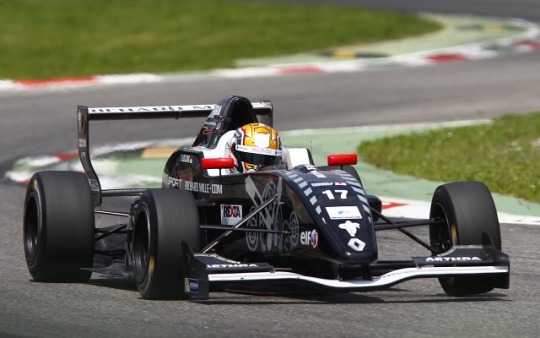
Leclerc marked himself out as a real prospect in karting – so much so he topped our 2012 ‘karters to watch‘ feature, ahead of Verstappen. But it’s never a foregone conclusion that a successful karter will make a successful car racer. His debut season in FR2.0 was in some ways fairly low key with ‘only’ two wins, but the jump up from karting to continental FR2.0 is very rarely made to look easy by anybody. Leclerc ultimately finished as high up in the Alps standings as he could have been realistically expected to do so, given the presence of an on-form de Vries. It was actually up against tougher competition in the Eurocup that he really shone, with three consecutive P2s taking quite some doing in a series where nobody was particularly consistent.
Those performances suggested he would be capable of stepping up to F3, particularly as his old rival Verstappen had made it look easy and didn’t have the benefit of a year of car racing experience. And so he has proven to be. It’s still early days, but Leclerc has so far been the class of a large crop of rookies and taken the fight to proven F3 winners with multiple years of experience already under their belt.
His early performances are on a par with what last year’s star rookies Esteban Ocon and Verstappen were doing – in fact, his record of two wins and five podiums from the first six races replicates the 2014 champion’s start. If he keeps it up, he will deserve to be held in the same high esteem as them a few months down the line.
Off-track
No doubt assisted by the Bianchis’ tutelage, Leclerc signed with Todt Jr’s All Road Management firm in 2011. At present, Leclerc has no ties to F1 teams, but through his work with Felipe Massa, Pastor Maldonado and Bianchi, Todt has dealt with most of them and will be very well-placed to get his protege a role when the time comes.
A potential stumbling point is that most F1 teams are already overflowing with some serious sub-F1 prospects, but if he continues to impress as he’s doing at the moment, they could begin falling over each other to find a space for him.
Funding-wise, Leclerc benefits from partners usually tied to Todt’s projects, and watch maker Richard Mille (currently a sponsor of the Lotus F1 team) is his loyal main backer. And you’d imagine that being billed as a future F1 star from Monaco could well tempt some further future investment.
Verdict
In just his second season in single-seaters, Leclerc is quickly marking himself out as a star of the future with fine performances and two wins in his first couple of weekends in European F3, making him seriously stand out from a large and competitive grid.
While he’s got plenty in common with his old karting rival and Van Amersfoort F3 predecessor Verstappen, a lesser reputation and sensible management mean he’s unlikely to be making the jump straight up to F1 next year. He will therefore need to sustain this impressive form into an intermediate category like GP2 in order to make the grade.
But the signs are definitely there that Leclerc is one of the very top talents in the junior ranks right now, and that he’s capable of tasting success in F1 in the future.
His lifelong friend Bianchi was so sadly stopped in his tracks last year just when his F1 future was looking promising. In a few years’ time, Leclerc could just pick up where his mentor left off.
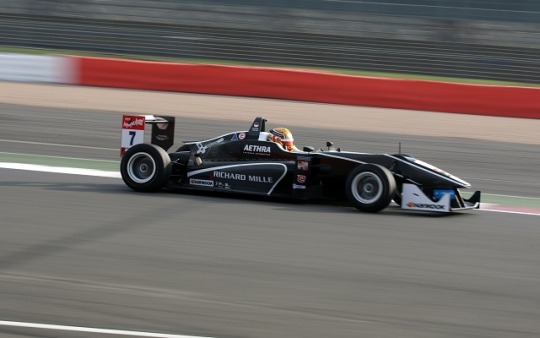
Allen, Peter. “Driver Profile: Charles Leclerc.” Formula Scout, May 7, 2015. https://www.paddockscout.com/driver-profile-charles-leclerc/27403.
11 notes
·
View notes